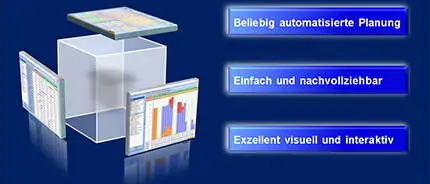Transparency – the supreme discipline of APS systems
The outstanding feature of APS systems is the comprehensive planning of value chains. Controlling production with an optimiser as a black box without sufficient intervention options does not lead to satisfactory results. The basic prerequisite for interactive intervention is also the supreme discipline for APS systems: The transparent visualisation of the planning situation.
To achieve this, it is necessary to portion the information correctly. It must be presented in a way that is easy to understand and there must be neither too much nor too little information. Dynamic filter options (e.g. on the critical path) and context-sensitive scaling are of great importance here. In order to be able to find out every detail, an aggregation across several levels is recommended, whereby the top level should contain the key parameters – logistical and economic – of the plan.
Basis for planning transparency
The basis for planning transparency is a data structure appropriate to the value creation process.
This includes, among other things
- Integration of design and quality assurance processes
- Realistic modelling of production processes (e.g. parallel processes) and industry specifics (e.g. shelf life)
- Practical modelling of lead times
The approach that throughput times result from the scheduling of the workload and that scheduling buffers can be dispensed with thanks to more detailed planning and more complex planning algorithms generally proves to be unsustainable. As only very few planners dispense with scheduling buffers, this approach is undermined, for example, by a reduced degree of utilisation of the resource – with the disadvantage that the scheduling buffer is no longer transparent and can no longer be reduced on an order-specific basis.
APS and traceability
Traceability is often mentioned in the same breath as transparency. For capacity-independent scheduling, this requirement also applies without restriction. However, as soon as capacity limits are taken into account – whether through optimisation, through a CTP check or through scheduling rules (with more than one order) – it will generally not be possible to trace why which operation was scheduled and how for any selected order. In these cases in particular, it is necessary to move away from the individual analysis of the orders and look at the plan as a whole with regard to its plausibility and problem cases. In order to maintain transparency across the entire plan, analyse it down to the smallest detail if necessary and quickly find the cause of deviations, particularly high demands must be placed on visualisation and information processing.
APS and the possibilities for intervention
Transparency creates the prerequisite for the planner to be able to find adequate solutions to planning problems using his situational experience. However, the APS system must also provide intervention options for implementation.
For example, if a planner still wants to keep a customer appointment that has been postponed by the optimiser, he could make the following interventions:
- Bring forward customer order
- Bring forward a production order for a finished product
- Increase capacity
- Batch size split for production order for assembly
- Change the assignment of a bottleneck component
It is important that the effects are calculated directly and are also visible in all analyses. Another important aspect is that these steps are easy to handle. For example, it is not possible in all APS systems to carry out a capacity adjustment in a simple way, to assign bottleneck components simply according to the business criteria of the customer order that caused them or to transfer changes to dates and quantities of production orders to the ERP system. However, if interventions can only be carried out in a complicated and time-consuming manner, there is a risk that planning will bypass the system. As a result, the image in the system moves further and further away from reality, with the consequence that the APS system is no longer used at some point or its planning specifications are no longer observed.
Ideally, the planner is supported by scenarios in which he can try out interventions without them becoming operationally effective. It should be possible to compare the scenario with operational planning and – if desired – to transfer the scenario’s planning steps to operational planning at the touch of a button.
Further information on the topic of value chain and logistics planning can be found under‘The logistics chain of a value chain‘ and under‘Supply chain management‘.
Image source: Wassermann AG
